sensor LINCOLN MKC 2018 Service Manual
[x] Cancel search | Manufacturer: LINCOLN, Model Year: 2018, Model line: MKC, Model: LINCOLN MKC 2018Pages: 571, PDF Size: 4.39 MB
Page 229 of 571

CROSS TRAFFIC ALERT (If Equipped)
WARNINGS
Do not use the cross traffic alert systemas a replacement for using the interiorand exterior mirrors or looking over yourshoulder before reversing out of a parkingspace. The cross traffic alert system is not areplacement for careful driving.
WARNINGS
The system may not operate properlyduring severe weather conditions, forexample snow, ice, heavy rain and spray.Always drive with due care and attention.Failure to take care may result in a crash.
The system is designed to alert you ofvehicles approaching from the sides whenyou shift into reverse (R).
Using the Cross Traffic Alert System
The system is designed to detect vehiclesthat approach with a speed up to 37 mph(60 km/h). Coverage decreases when thesensors are partially, mostly or fullyobstructed. Slowly reversing helps increasethe coverage area and effectiveness.
The system turns on when you start theengine and you shift into reverse (R). Thesystem turns off when you shift out of reverse(R).
226
MKC (TME) Canada/United States of America, JJ7J 19A321 AA enUSA, Edition date: 201707, Second Printing
Driving Aids
Page 230 of 571
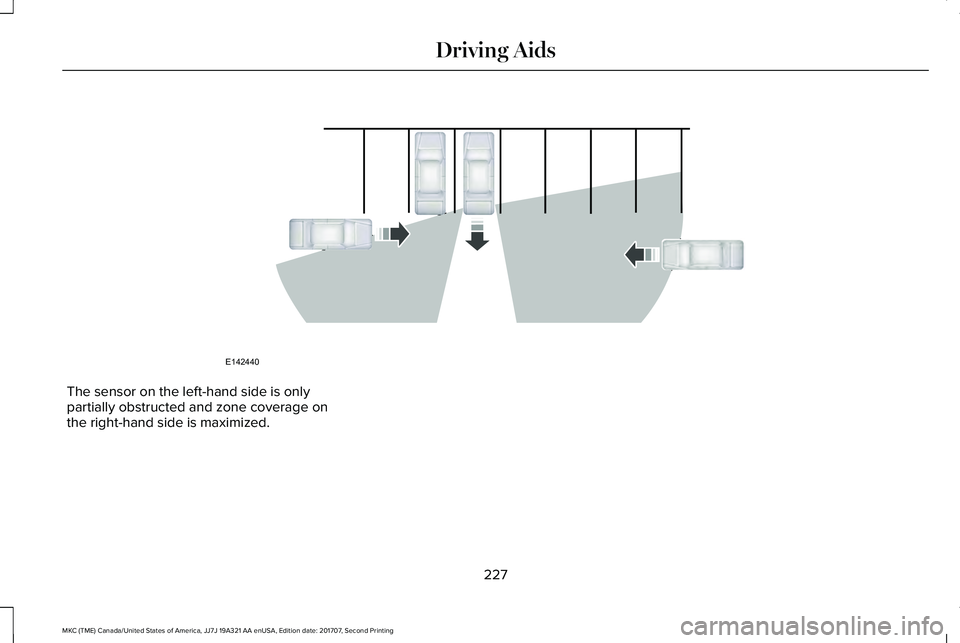
The sensor on the left-hand side is onlypartially obstructed and zone coverage onthe right-hand side is maximized.
227
MKC (TME) Canada/United States of America, JJ7J 19A321 AA enUSA, Edition date: 201707, Second Printing
Driving AidsE142440
Page 231 of 571
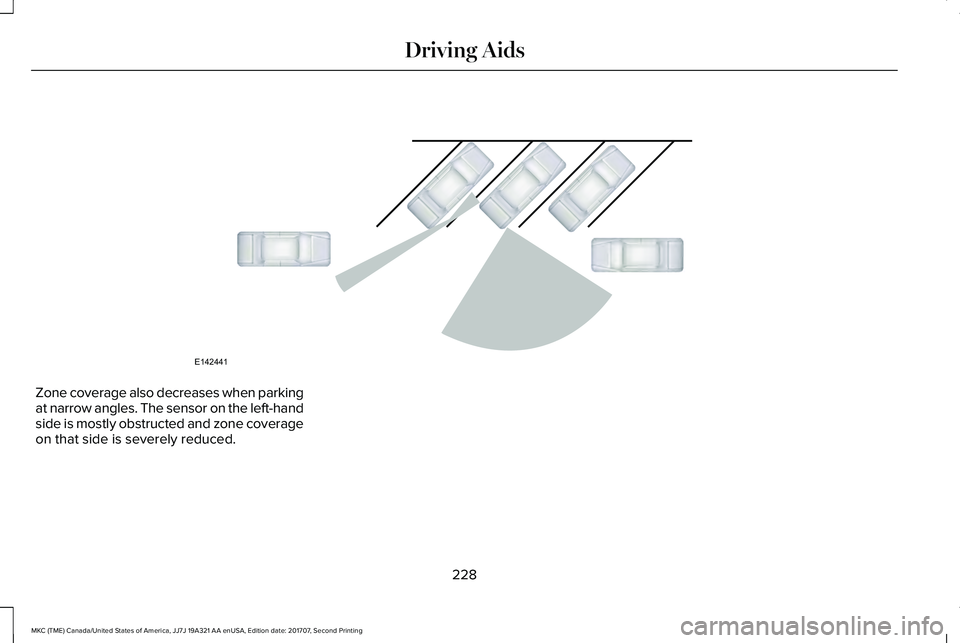
Zone coverage also decreases when parkingat narrow angles. The sensor on the left-handside is mostly obstructed and zone coverageon that side is severely reduced.
228
MKC (TME) Canada/United States of America, JJ7J 19A321 AA enUSA, Edition date: 201707, Second Printing
Driving AidsE142441
Page 232 of 571
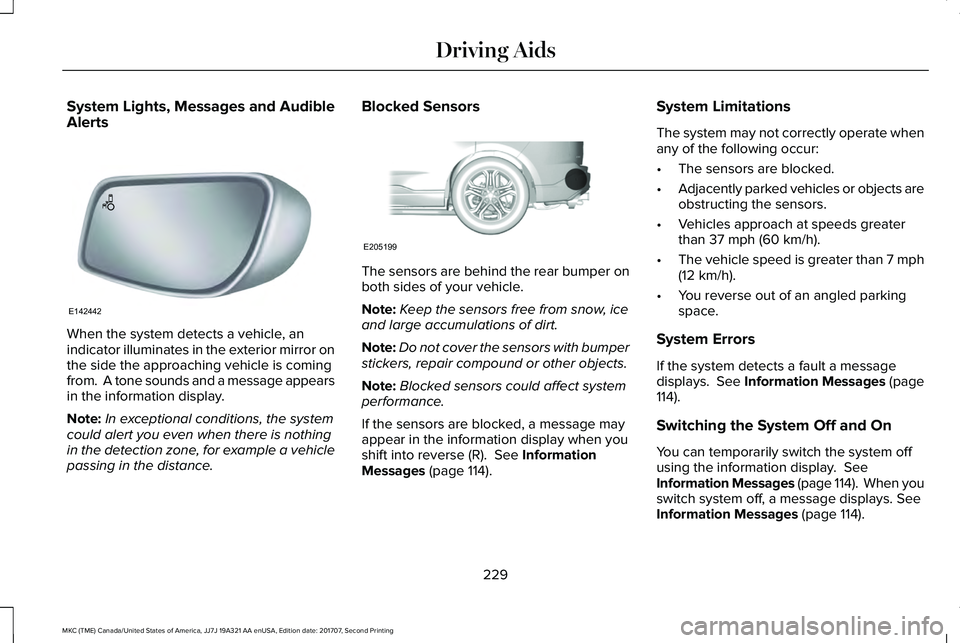
System Lights, Messages and AudibleAlerts
When the system detects a vehicle, anindicator illuminates in the exterior mirror onthe side the approaching vehicle is comingfrom. A tone sounds and a message appearsin the information display.
Note:In exceptional conditions, the systemcould alert you even when there is nothingin the detection zone, for example a vehiclepassing in the distance.
Blocked Sensors
The sensors are behind the rear bumper onboth sides of your vehicle.
Note:Keep the sensors free from snow, iceand large accumulations of dirt.
Note:Do not cover the sensors with bumperstickers, repair compound or other objects.
Note:Blocked sensors could affect systemperformance.
If the sensors are blocked, a message mayappear in the information display when youshift into reverse (R). See InformationMessages (page 114).
System Limitations
The system may not correctly operate whenany of the following occur:
•The sensors are blocked.
•Adjacently parked vehicles or objects areobstructing the sensors.
•Vehicles approach at speeds greaterthan 37 mph (60 km/h).
•The vehicle speed is greater than 7 mph(12 km/h).
•You reverse out of an angled parkingspace.
System Errors
If the system detects a fault a messagedisplays. See Information Messages (page114).
Switching the System Off and On
You can temporarily switch the system offusing the information display. SeeInformation Messages (page 114). When youswitch system off, a message displays. SeeInformation Messages (page 114).
229
MKC (TME) Canada/United States of America, JJ7J 19A321 AA enUSA, Edition date: 201707, Second Printing
Driving AidsE142442 E205199
Page 234 of 571
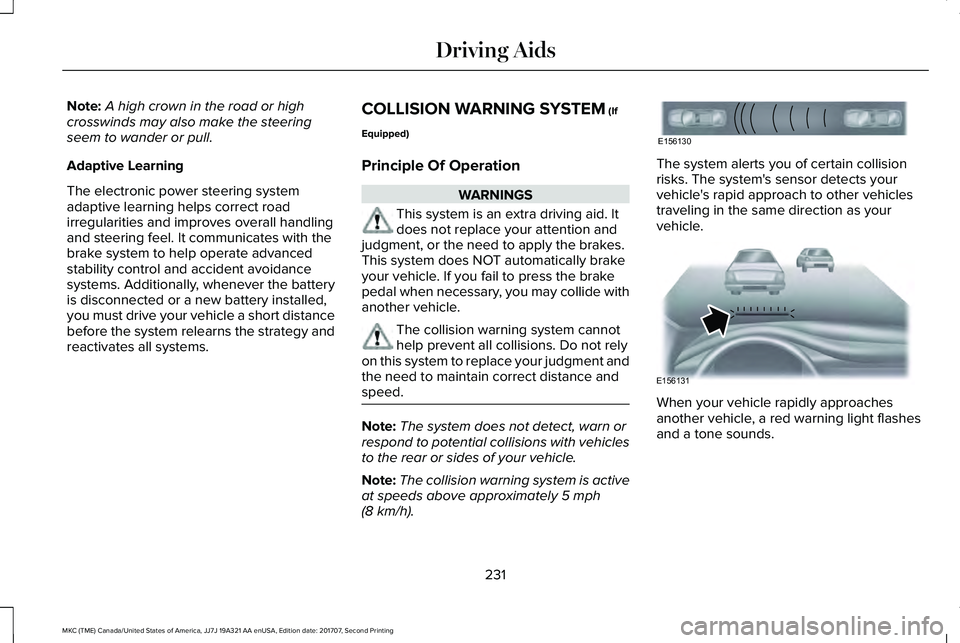
Note:A high crown in the road or highcrosswinds may also make the steeringseem to wander or pull.
Adaptive Learning
The electronic power steering systemadaptive learning helps correct roadirregularities and improves overall handlingand steering feel. It communicates with thebrake system to help operate advancedstability control and accident avoidancesystems. Additionally, whenever the batteryis disconnected or a new battery installed,you must drive your vehicle a short distancebefore the system relearns the strategy andreactivates all systems.
COLLISION WARNING SYSTEM (If
Equipped)
Principle Of Operation
WARNINGS
This system is an extra driving aid. Itdoes not replace your attention andjudgment, or the need to apply the brakes.This system does NOT automatically brakeyour vehicle. If you fail to press the brakepedal when necessary, you may collide withanother vehicle.
The collision warning system cannothelp prevent all collisions. Do not relyon this system to replace your judgment andthe need to maintain correct distance andspeed.
Note:The system does not detect, warn orrespond to potential collisions with vehiclesto the rear or sides of your vehicle.
Note:The collision warning system is activeat speeds above approximately 5 mph(8 km/h).
The system alerts you of certain collisionrisks. The system's sensor detects yourvehicle's rapid approach to other vehiclestraveling in the same direction as yourvehicle.
When your vehicle rapidly approachesanother vehicle, a red warning light flashesand a tone sounds.
231
MKC (TME) Canada/United States of America, JJ7J 19A321 AA enUSA, Edition date: 201707, Second Printing
Driving AidsE156130 E156131
Page 235 of 571
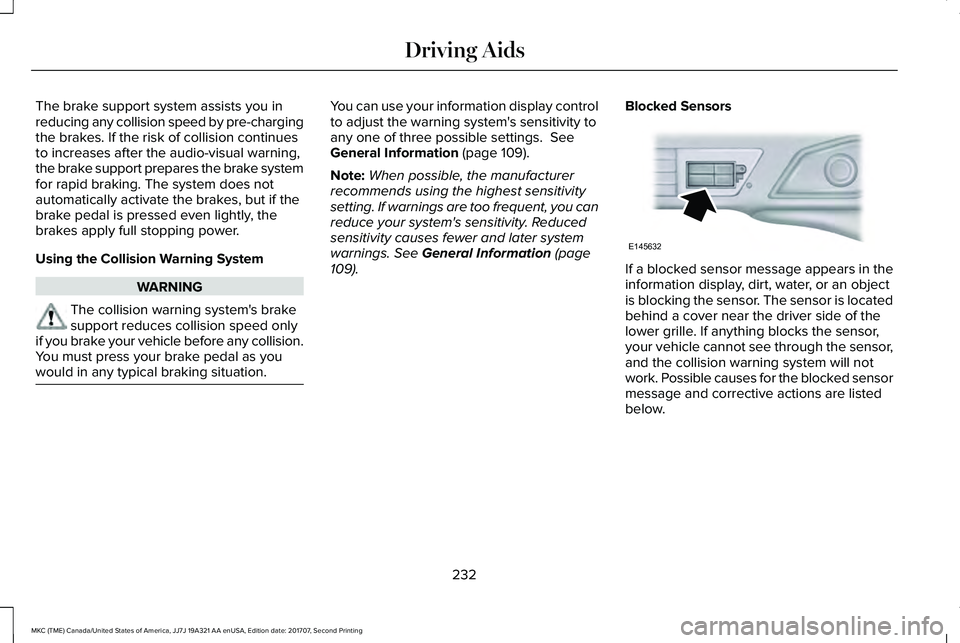
The brake support system assists you inreducing any collision speed by pre-chargingthe brakes. If the risk of collision continuesto increases after the audio-visual warning,the brake support prepares the brake systemfor rapid braking. The system does notautomatically activate the brakes, but if thebrake pedal is pressed even lightly, thebrakes apply full stopping power.
Using the Collision Warning System
WARNING
The collision warning system's brakesupport reduces collision speed onlyif you brake your vehicle before any collision.You must press your brake pedal as youwould in any typical braking situation.
You can use your information display controlto adjust the warning system's sensitivity toany one of three possible settings. SeeGeneral Information (page 109).
Note:When possible, the manufacturerrecommends using the highest sensitivitysetting. If warnings are too frequent, you canreduce your system's sensitivity. Reducedsensitivity causes fewer and later systemwarnings. See General Information (page109).
Blocked Sensors
If a blocked sensor message appears in theinformation display, dirt, water, or an objectis blocking the sensor. The sensor is locatedbehind a cover near the driver side of thelower grille. If anything blocks the sensor,your vehicle cannot see through the sensor,and the collision warning system will notwork. Possible causes for the blocked sensormessage and corrective actions are listedbelow.
232
MKC (TME) Canada/United States of America, JJ7J 19A321 AA enUSA, Edition date: 201707, Second Printing
Driving AidsE145632
Page 236 of 571

ActionCause
Clean the radar sensor cover or remove the obstruction.The radar sensor cover in the grille is dirty or obstructed.
Wait a short time. The radar may take several minutes to reset afteryou remove the obstruction.The surface of the radar sensor cover is clean but the messageremains in the display.
The collision warning system is temporarily disabled. Shortly afterweather conditions improve, the collision warning system automaticallyreactivates.
Heavy rain, spray, snow or fog in the air interferes with the radarsignals.
The collision warning system is temporarily disabled. Shortly afterweather conditions improve, the collision warning system automaticallyreactivates.
Swirling water, snow or ice on the road surface interferes with theradar signals.
System Limitations
Due to the nature of radar technology, theremay be certain instances where vehicles donot provide a collision warning. Theseinclude:
•Stationary vehicles or vehicles movingbelow 6 mph (10 km/h).
•Pedestrians or objects in the roadway.
•Oncoming vehicles in the same lane.
•Severe weather conditions (see blockedsensor section).
•Debris build-up on the grille near theheadlamps (see blocked sensor section).
•Small distance to vehicle ahead.
•Large steering wheel and pedalmovements (very active driving style).
Damage to the front end of the vehicle mayalter the radar sensor's coverage area. Thismay result in missed or false collisionwarnings. Have an authorized dealer checkyour radar sensor for proper coverage andoperation.
233
MKC (TME) Canada/United States of America, JJ7J 19A321 AA enUSA, Edition date: 201707, Second Printing
Driving Aids
Page 274 of 571
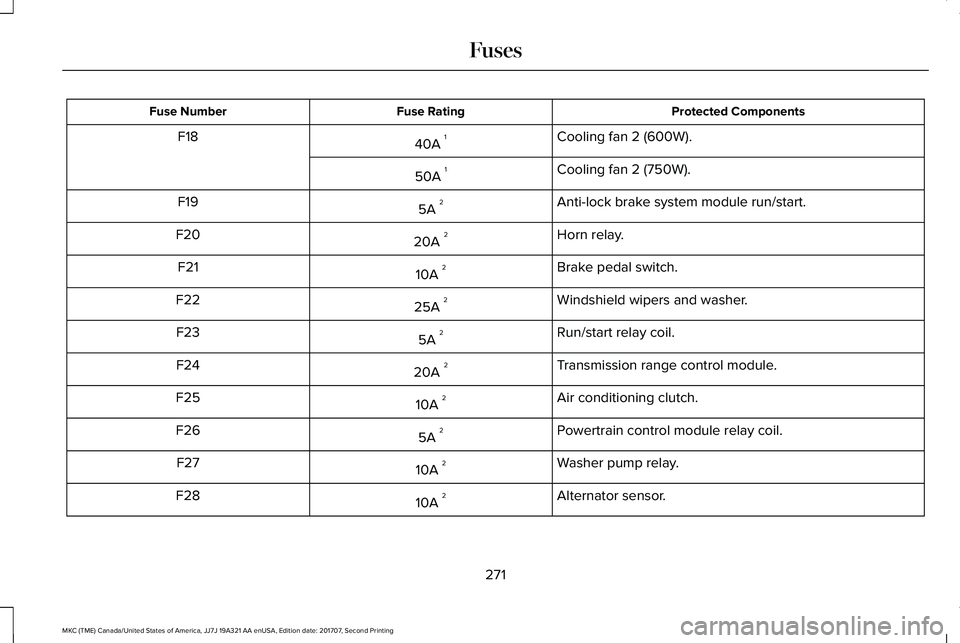
Protected ComponentsFuse RatingFuse Number
Cooling fan 2 (600W).40A 1F18
Cooling fan 2 (750W).50A 1
Anti-lock brake system module run/start.5A 2F19
Horn relay.20A 2F20
Brake pedal switch.10A 2F21
Windshield wipers and washer.25A 2F22
Run/start relay coil.5A 2F23
Transmission range control module.20A 2F24
Air conditioning clutch.10A 2F25
Powertrain control module relay coil.5A 2F26
Washer pump relay.10A 2F27
Alternator sensor.10A 2F28
271
MKC (TME) Canada/United States of America, JJ7J 19A321 AA enUSA, Edition date: 201707, Second Printing
Fuses
Page 275 of 571
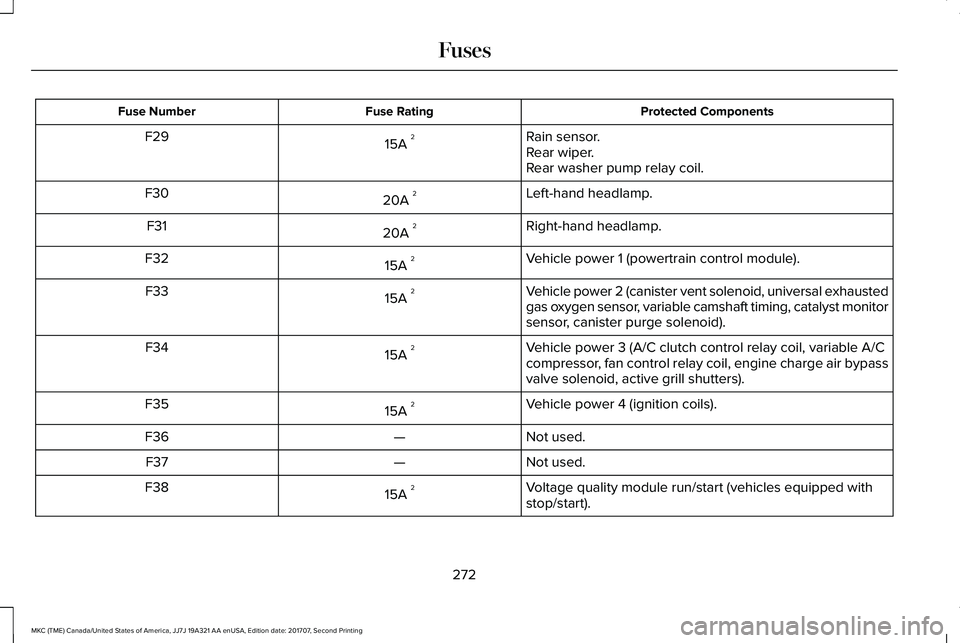
Protected ComponentsFuse RatingFuse Number
Rain sensor.15A 2F29Rear wiper.Rear washer pump relay coil.
Left-hand headlamp.20A 2F30
Right-hand headlamp.20A 2F31
Vehicle power 1 (powertrain control module).15A 2F32
Vehicle power 2 (canister vent solenoid, universal exhaustedgas oxygen sensor, variable camshaft timing, catalyst monitorsensor, canister purge solenoid).
15A 2F33
Vehicle power 3 (A/C clutch control relay coil, variable A/Ccompressor, fan control relay coil, engine charge air bypassvalve solenoid, active grill shutters).
15A 2F34
Vehicle power 4 (ignition coils).15A 2F35
Not used.—F36
Not used.—F37
Voltage quality module run/start (vehicles equipped withstop/start).15A 2F38
272
MKC (TME) Canada/United States of America, JJ7J 19A321 AA enUSA, Edition date: 201707, Second Printing
Fuses
Page 332 of 571
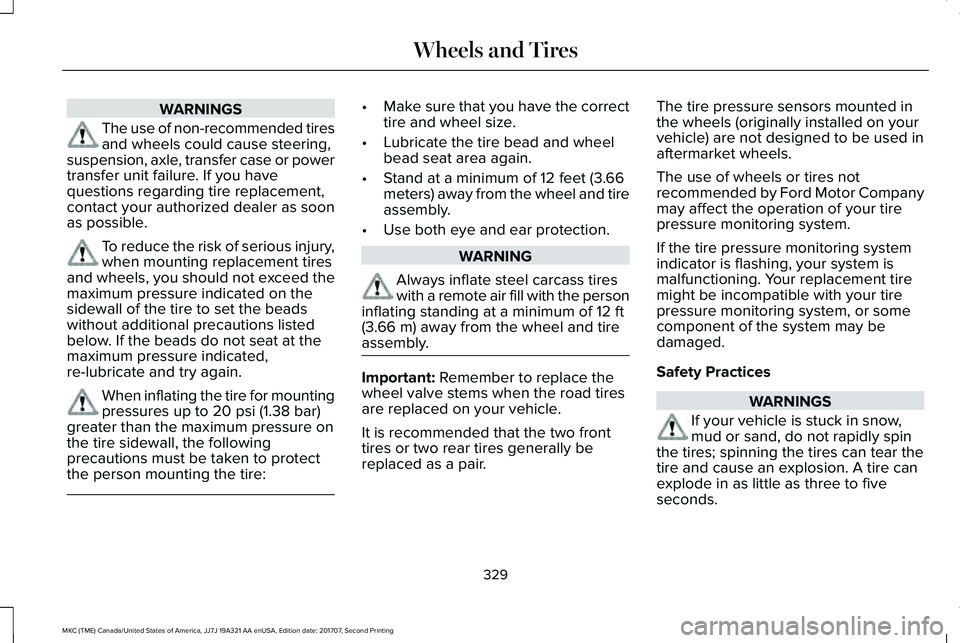
WARNINGS
The use of non-recommended tiresand wheels could cause steering,suspension, axle, transfer case or powertransfer unit failure. If you havequestions regarding tire replacement,contact your authorized dealer as soonas possible.
To reduce the risk of serious injury,when mounting replacement tiresand wheels, you should not exceed themaximum pressure indicated on thesidewall of the tire to set the beadswithout additional precautions listedbelow. If the beads do not seat at themaximum pressure indicated,re-lubricate and try again.
When inflating the tire for mounting
pressures up to 20 psi (1.38 bar)greater than the maximum pressure onthe tire sidewall, the followingprecautions must be taken to protectthe person mounting the tire:
•Make sure that you have the correcttire and wheel size.
•Lubricate the tire bead and wheelbead seat area again.
•Stand at a minimum of 12 feet (3.66meters) away from the wheel and tire
assembly.
•Use both eye and ear protection.
WARNING
Always inflate steel carcass tireswith a remote air fill with the personinflating standing at a minimum of 12 ft(3.66 m) away from the wheel and tireassembly.
Important: Remember to replace thewheel valve stems when the road tires
are replaced on your vehicle.
It is recommended that the two fronttires or two rear tires generally bereplaced as a pair.
The tire pressure sensors mounted inthe wheels (originally installed on yourvehicle) are not designed to be used inaftermarket wheels.
The use of wheels or tires notrecommended by Ford Motor Companymay affect the operation of your tirepressure monitoring system.
If the tire pressure monitoring systemindicator is flashing, your system ismalfunctioning. Your replacement tiremight be incompatible with your tirepressure monitoring system, or somecomponent of the system may bedamaged.
Safety Practices
WARNINGS
If your vehicle is stuck in snow,mud or sand, do not rapidly spinthe tires; spinning the tires can tear thetire and cause an explosion. A tire canexplode in as little as three to fiveseconds.
329
MKC (TME) Canada/United States of America, JJ7J 19A321 AA enUSA, Edition date: 201707, Second Printing
Wheels and Tires